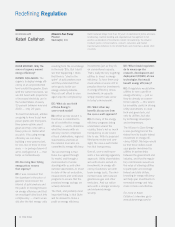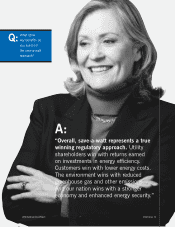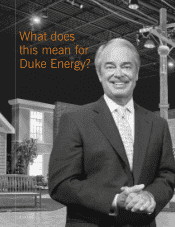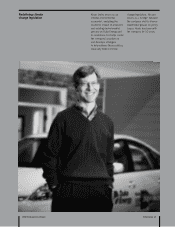Duke Energy 2008 Annual Report Download - page 24
Download and view the complete annual report
Please find page 24 of the 2008 Duke Energy annual report below. You can navigate through the pages in the report by either clicking on the pages listed below, or by using the keyword search tool below to find specific information within the annual report.
22 Duke Energy
From left to right:
Catherine Heigel
Associate General Counsel,
Duke Energy Carolinas
Charlotte, N.C.
Raiford Smith
Director,
Marketing Operations,
Marketing and Energy Efficiency
Charlotte, N.C.
Dick Stevie
Managing Director,
Customer Market Analytics
Corporate Strategy and Planning
Cincinnati, Ohio
▲
this increase in energy efficiency has no
impact on their comfort and convenience.
In fact, in other areas where this technology
is in use, customers often aren’t even aware
of it until they see the savings on their monthly
electric bill.
This grid optimization project is just one
way we are using new technologies to go
beyond the meter — to create new partner-
ships with our customers to significantly
increase energy efficiency and reduce our
environmental impact.
Regulation Focus
Imagine a regulated utility where customers
are charged for the value they receive instead
of the costs incurred. In such a world, utilities
would focus on lowering their costs and
delivering valuable services to customers.
If the services don’t produce value, the
customer doesn’t pay.
This is the basic premise behind Duke
Energy’s innovative save-a-watt approach to
energy efficiency. It is a fundamental shift
away from the traditional cost-of-service
model, focusing instead on a value-of-service
regulatory model. Under save-a-watt, Duke
Energy must ensure that its energy efficiency
programs produce value in the form of verifi-
able energy reductions in order for the
company to recover its costs.
This simple concept changes the utility’s focus
from spending money to creating value for
customers. Such a transformation is not
simple. In traditional cost-of-service regulatory
models, customers pay a charge for every
kilowatt-hour they consume. Utilities recover
their costs and earn a return for investments in
physical assets (such as power plants, poles
and meters). But energy efficiency undermines
the utility’s profitability through reduced sales.
On the other hand, the save-a-watt model
provides compensation based on the value
created — a portion of the cost avoided from
not building new plants. It also provides
a comparable return on investments in
physical assets.
Unlike other regulatory approaches to energy
efficiency, save-a-watt ensures customers
only pay for actual reductions in energy use
because all programs undergo a rigorous third-
party process to verify their energy savings.
Under more traditional regulatory models,
customers pay for energy efficiency programs,
regardless of whether they achieve the
intended results. If power has to be sourced
to compensate for a shortfall in energy
efficiency, customers end up paying twice —
once for the energy efficiency programs and
again for the cost of the power. But under the
save-a-watt model, the utility takes the risk:
If the intended energy efficiency results aren’t
achieved, the customer doesn’t pay.
Because returns are based on customer
value and not on how much was spent on
the programs, the save-a-watt model ensures
that the utility stays focused on lowering
costs and increasing energy reductions for
customers. This also encourages the utility
to develop innovative energy-saving services
that will achieve more energy reductions
and lower costs for customers.
For example, to increase customer adoption
and awareness, we are partnering with major
retailers on new energy efficiency products.
Furthermore, we’re working with local
com panies to hire additional staff to implement
our programs. Customers who participate
in the save-a-watt program will save money
by reducing their usage. Additionally, all
customers will save money because over
the long term, the utility will be able to
defer building new power plants. Better yet,
combining energy efficiency with a smart
grid — another Duke Energy initiative (see
page 20) — will generate even more savings.
The save-a-watt approach to energy efficiency
will help customers save money, create jobs
for our economy and reduce environmental
impacts. At the same time, it provides utilities
with a way to grow their business. It truly is
a win for customers, the local community,
investors and the environment. Our save-a-
watt program was approved by Ohio regulators
late last year. We continue to seek its regula-
tory approval in the other states where we
have regulated utility operations.
























